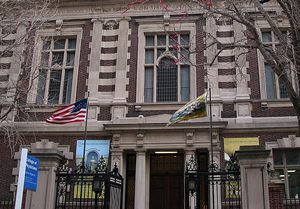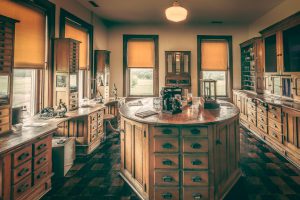Medical museums catalogue the history of biomedicine (using empirical sciences to understand illness and disease) by displaying medical instruments, preserved specimens as examples of pathologies and anomalies, and photography. The museums I will be using as examples are the Mütter Museum and the Indiana Medical History Museum. The aims for these museums is to show how biomedicine, and the science upon which its predicated, follows a linear progression from ‘primitive’ practices to contemporary practices, which are understood as scientifically enlightened and valorized.
First, it is necessary to unpack what museums do and how they do it. Museums are ostensibly places for education and entertainment. At once, they teach and titillate. They impart ways of viewing and classifying the world onto the visitor, implicating them in narratives of history, evolution, and selfhood. Visitors to medical museum not only fulfill morbid curiosities, but place themselves within the narratives of medical progress. But at what cost? Whose bodies are used to tell which stories? Whose suffering is the currency of knowledge? Who has the authority to turn people who have these abnormalities into curiosities and objects of education and entertainment?

The Mütter Museum, founded and operated by the College of Physicians of Philadelphia, is possibly the most famous medical museum in America. Among its most famous displayed artifacts are the ‘Soap Lady’, Albert Einstein’s brain, President Grover Cleveland’s jaw tumor, and a cast of Chang and Eng Bunker’s liver. The museum’s website states that the specimens and photographs are ‘beautifully preserved…in a 19th-century ‘cabinet museum’ setting’ (http://muttermuseum.org/about/). By associating itself with a professional organization for medical doctors, the Mütter Museum places itself as a medical education institution that bases medical history on the presences and purging of bodily abnormalities and trauma.

The Indiana Medical History Museum is located in Indianapolis, Indiana. It occupies the now defunct Central State Hospital, an old psychiatric hospital. Visitors are taken through lecture halls, surgical theaters, and laboratories where specimens and tools are displayed. Among the exhibits advertised on the website (warning: graphic depictions of surgery) are a recreated family practitioner’s office from the early or mid 20th century, an exhibit about lobotomies, and the connection between mass incarcerations and mental illness.
By connecting these museums, the pathologies they exhibit, the narratives of progress and evolution, and the questions about embodied suffering and difference through illness and disease, we can understand how collecting the manifestations of biological and physical difference plays into the pathologizing of difference, be it mental or physical. This pathologizing process casts disability, culturally different categories of selfhood and embodiment, and the self into rigid categories of ‘normal’. We must interrogate the means by which our entertainment, education, and knowledge of mental and physical illness and differences stems from visiting and viewing these places. The objectification of illness and difference fits in with the history of objectifying and doing violence to bodies of color, including Indigenous bodies.
Works Cited
Images
[The Indiana Medical History Museum]. (n.d.). Retrieved April 4, 2017, from http://www.imhm.org/Resources/Pictures/_B0A1128-HDR-Edit.jpg
[Mütter Museum Exterior]. (n.d.). Retrieved April 4, 2017, from http://pabook2.libraries.psu.edu/palitmap/MutterBuilding.jpg
Works Cited
Arnold, K., & Söderqvist, T. (2011). Medical Instruments in Museums: Immediate Impressions and Historical Meanings. Isis, 102(4), 718-729. doi:10.1086/663613
Indiana Medical History Museum. (n.d.). Exhibits. Retrieved from imhm.org: http://www.imhm.org/Exhibits
Indiana Medical History Museum. (n.d.). LOBOTOMY: INTENTIONS, PROCEDURES, EFFECTS. Retrieved from imh.org: http://www.imhm.org/page-1854827
The Mutter Museum. (n.d.). About. Retrieved from muttermuseum.org: http://muttermuseum.org/about/
Wilson, E. K. (2015), The Collection and Exhibition of a Fetal and Child Skeletal Series. Mus Anthropol, 38: 15–27. doi:10.1111/muan.12070
